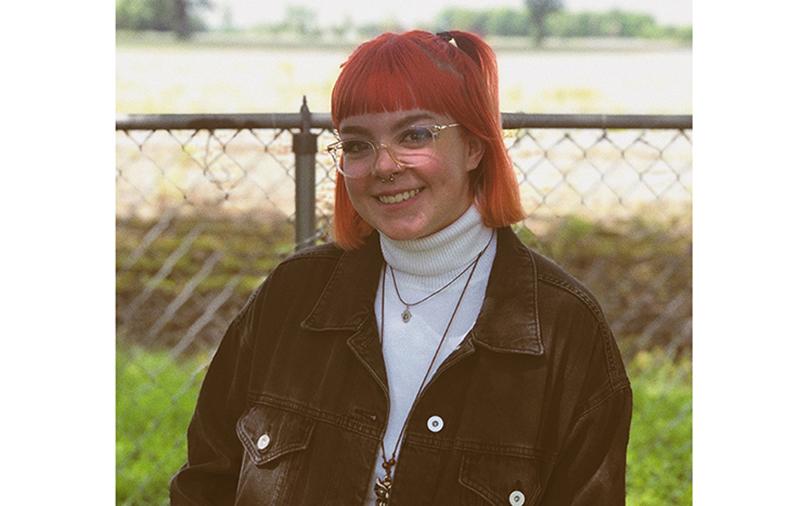Article by: Ellen Lampert-Greaux, Live Design
Jaden C. O’Berry is a rising junior and recognized Distinguished Theatre Arts Scholar at Saginaw Valley State University, earning a BA degree in Theatre with a focus in Lighting Design and Electrics. Jaden was the 2020 Lighting (DTM) Regional Design Project Winner this past January at the Kennedy Center American College Theatre Festival for her work on Qui Nguyen’s She Kills Monsters. She hopes to continue creating more art that challenges the mold, and bringing light to stories that have an impact on not only the audiences that view them, but on herself as well. Some of her other credits include Roustabout by Jay Torrence (lighting designer, SVSU Theatre Department), The Rocky Horror Show by Richard O’Brien (lighting designer/master electrician, Rebel Theatre Company), and Spring Awakening by Duncan Sheik and Steven Sater (lighting designer/master electrician, Tri-Cities Young Adult Theatre Company). She is one of the winners in the second round of Pat MacKay Diversity in Design scholarships presented by Live Design/LDI in conjunction with TSDCA and USITT.
Live Design: Why did you apply for the Pat MacKay Diversity In Design Scholarship?
Jaden C. O’Berry: I applied for the Pat MacKay Diversity in Design Scholarship because I always want to try and strive for larger opportunities for my design career, but also because representing all of the women and LGBTQIA+ people in the industry (especially in design) is something incredibly important to me. I want to show that it doesn’t matter how or why people perceive (or care) who you love, and it shouldn’t drive anyone in this industry to remove someone from a job or opportunity just based on hurtful biases. We are all on this planet to create something beautiful: a life lived in the brightest and most fulfilling ways possible. One of my ways just happens to be theatrical lighting design.
LD: What made you interested in the field of lighting, projection/video, or audio design?
JB: Lighting has always been the one thing that carries me away from stress and worry. I have been a technician and lighting designer since my freshman year of high school. At that time, I struggled with who I was and my own identity—as many kids do in school these days. When I am working in the theatre, I find myself lost in the worlds that are created on stage, and lost in the different elements or facets of designs that make up the world as a whole. Building the lives and backgrounds of the characters in playwriting, directing, or acting is one large puzzle piece—whereas building the things those characters are supposed to see every day in design is a whole other ballgame. I am just grateful I get to be one of those creators involved, even if the ballgame gets stressful, or the puzzle pieces don’t quite fit. It is all about improvising and adapting to new situations—after all, that’s live theatre.
LD: What are your career goals?
JB: My main goal as a lighting designer/electrician is to travel with different shows or companies to further my exposure and knowledge on design. Hopefully, I will also be traveling to different festivals and conferences to see what new technology or trends are in store for the future.
I want to be exposed to so many different ways of tech and lighting, that the knowledge will fill my brain with even more ideas of how to put my heart, my personal stamp, into the design world. Once I find myself sated on travel, if possible, I plan on moving to Chicago, Illinois where I can remain as a resident designer in a theatre there. That city has held a piece of my soul since I went there as a kid; I’ve missed it ever since.
LD: How can the industry better serve underrepresented communities?
JB: The industry can better serve underrepresented communities by first acknowledging that those communities are underrepresented. Remaining silent during the time of revolution places you on the side of the oppressor.
I believe the industry can also better serve by becoming more knowledgeable about the underrepresented communities’ culture or history, so they understand the inner workings of who we are and what exactly we fight for. Knowledge is the most powerful weapon anyone can carry with themselves, right alongside compassion and empathy.
LD: Who or what are your influences, in terms of people or events?
JB: My main influence is my very own university’s technical director/liaison, Peggy Mead-Finizio. I could write a book on how much I have learned about not only my job, but my life, from this woman. She inspires me and encourages me to challenge the mold in my designs, even (and especially!) if I find myself frustrated with an element of the process. Not only that, but her kindness and compassion even when things can become overwhelming keeps me going in my everyday life, and encourages me to be a better person in my own world outside of the theatre. There is a beauty in the way Peggy can teach without even realizing she is changing her student’s lives, in the best way, by exposing them to art. Even if that isn’t their background or career field. I hope one day to be even a touch of who Peggy is.
Another influence in my design career has also been the works of Shakespeare. I am a Theatre major with a double minor in English and Creative Writing, so to say William Shakespeare has changed my perception of literature and art would be an understatement. There is no proper way to give justice to the impact he has made on my, and many others’ lives. The worlds he molded will always somehow find a way to be reflected in my own work—whether in an idea or specific “picture” onstage.
LD: Are there particular challenges you have faced?
JB: As a member of the LGBTQIA+ community, it is extremely hard to find a balance of what is “accepted” by societal norms. For example, I have yet to come out to some of the closest people in my life out of fear of them not understanding, or leaving me due to their own beliefs. Especially as a pansexual woman, that is a title not used as commonly as others, or at least one that’s not represented as much in “everyday” culture. Meanwhile, I find myself working in one of the most accepting and open career fields there is—the arts —in turn, making me feel silly for thinking I have to hide who I am. But that’s how so many of us feel on a day-to-day basis. It is a heartbreaking struggle choosing how to identify yourself purely out of fear of being judged in our heteronormative society. There’s a pressure to remain silent while also a desire to show the realest version of myself—which is where my art comes in. Lighting is truly the only way I have ever felt at home in my own skin, where I’ve felt the most alive instead of just living.
Off
Support USITT
For many 501(c)3 nonprofit organizations, USITT included, donations are a lifeline. We are able to continue to expand our online offerings to our Members and to our industry thanks to Membership dollars and the generosity of our donors.







